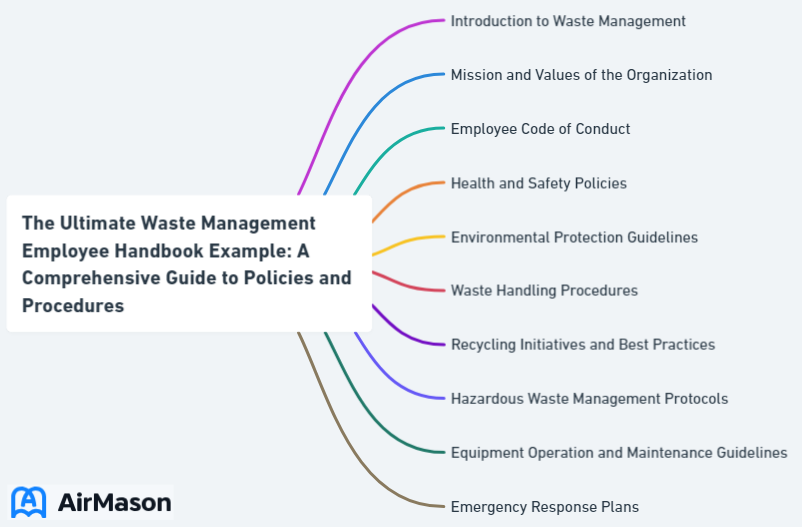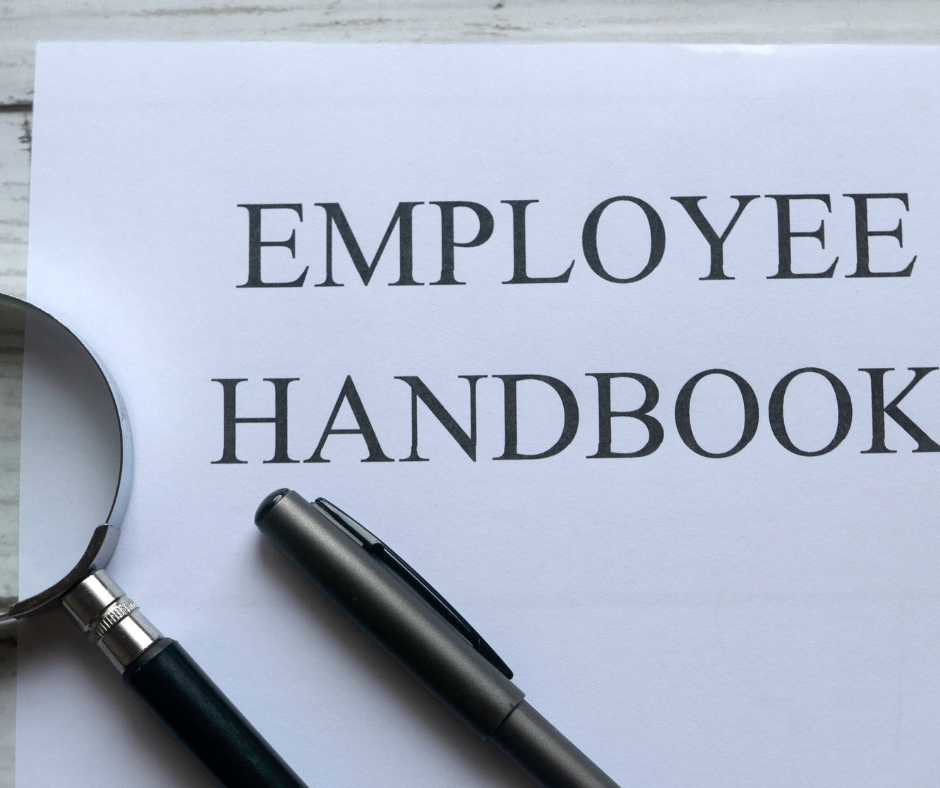
The waste management industry is crucial for maintaining a clean and safe environment. An employee handbook can be a powerful tool in ensuring the efficiency of waste management operations, legal compliance, and employee satisfaction. This comprehensive guide will help you create the ultimate Waste Management Employee Handbook Example by covering essential elements, implementing consistent standards, adapting to significant changes, and customizing it to reflect your company’s unique culture and values.
Key Takeaways
- Create a comprehensive Waste Management Employee Handbook to ensure organizational efficacy and conformity with regulatory requirements.
- Enforce ethical standards, safety guidelines, environmental policies & federal laws while fostering an accountable work environment.
- Involve employees in the development process to create an inclusive resource that reflects company culture and values.
Fortune 100 Company Employee Handbook
Welcome to our esteemed Fortune 100 company! This “Fortune 100 Company Employee Handbook” serves as your comprehensive guide to understanding our organization’s policies, values, and expectations. As a member of our dynamic team, it is crucial to familiarize yourself with the content within this handbook, ensuring a smooth integration into our corporate culture. The “Fortune 100 Company Employee Handbook” outlines the principles that define our commitment to excellence, integrity, and innovation. We encourage you to refer to this invaluable resource regularly to uphold our shared values and contribute to the ongoing success of our world-class organization.
Creating a Waste Management Employee Handbook: Key Elements
A well-designed waste management employee handbook serves as a primary source of information and guidance for personnel regarding company policies, expectations, and procedures. It guarantees consistency in communication and conformity with regulatory requirements, improving organizational efficacy and minimizing legal risks.
An effective employee handbook should include four key elements:
- Company policies and ethical standards
- Safety guidelines and procedures
- Environmental compliance and federal laws
- Human resources policies and recruitment practices

Company Policies and Ethical Standards
Setting forth clear guidelines for employee behavior, communication, and performance expectations fosters a professional and accountable work environment, while also minimizing the risk of legal liability. Employees are expected to carry out their job duties responsibly and with respect for customers, stakeholders, and the wider community. This includes demonstrating ethical conduct at all times. Supervisors and managers must adhere to the principles of authority and must not abuse their authority. In cases where these guidelines are not followed, disciplinary action may be necessary.
In addition to outlining ethical and professional standards, the employee handbook should also cover policies regarding employee benefits, communication, and safeguarding company property. Ensuring employees comprehend and adhere to these policies allows the company to safeguard its assets and uphold a positive workplace culture.
Safety Guidelines and Procedures
Safety guidelines and procedures are indispensable in ensuring the well-being of waste management employees. The employee handbook should outline standardized safety protocols for handling hazardous materials, safeguarding employee well-being, and complying with industry regulations.
Positive reinforcement during the implementation of an Occupational Safety and Health Management system motivates employees to be attentive and comply with company policy, thereby promoting a culture of safety. Standardized safety protocols should include proper identification and labeling of waste containers, periodic waste pick-ups, and adherence to disposal procedures for hazardous waste.
Environmental Compliance and Federal Laws
The inclusion of environmental policies and guidelines in the employee handbook encourages responsible waste disposal, mitigates environmental risks, and confirms adherence to federal regulations. Instituting explicit environmental policies and guiding principles helps diminish the company’s impact on the environment while encouraging prudent disposal techniques and confirming adherence with requisite regulations.
Essential areas to be included in the environmental safety protocols are:
- Decreasing waste
- Managing and discarding hazardous materials
- Conserving energy
- Conserving water
Providing practical examples of environmentally responsible practices enables employees to make judicious decisions. This could take the form of face-to-face instruction, educational videos, or pamphlets.
Human Resources Policies and Recruitment Practices
The development of human resources policies and recruitment practices that cultivate a welcoming work environment is key for employee satisfaction and productivity. The employee handbook should cover multiple topics, including:
- Recruitment
- Training
- Benefits
- Health & safety guidelines
- Anti-discrimination
- Harassment complaints procedures
- Disciplinary actions
All of these ensure a successful workplace environment for everyone.
Employee development programs, such as skill enhancement programs, cross-training opportunities, and internal mobility programs, can be beneficial for both employees and the waste management organization. By investing in the growth of employees, the company can ensure a skilled workforce capable of tackling the challenges of the waste management industry.
Implementing a Consistent Standard Across the Organization

Enforcing consistent standards throughout the organization is necessary to ensure uniformity and compliance with company policies. Fostering open communication, reporting, and providing regular training not only ensures compliance but also cultivates a culture of consistency and responsibility within the organization, leading to more productive and efficient waste management processes.
Open Communication and Reporting

Creating a transparent work environment that encourages employees to voice concerns, seek answers, and get feedback is vital in sustaining a healthy organizational culture. Effective reporting systems, such as:
- VelocityEHS
- ServiceCore
- Trash Flow
- WAM Software
By addressing issues in a timely manner, we can ensure accurate and timely information for employees.
Engaging employees in the creation of a waste management employee handbook can encourage a feeling of ownership and responsibility, resulting in higher compliance with the regulations set out in the handbook. Regularly emphasizing the significance of feedback and making multiple feedback channels available can help in promoting employee feedback regarding the waste management employee handbook.
Whirlpool Employee Handbook Example
Explore the comprehensive guidelines and policies within the Whirlpool employee handbook example, designed to foster a positive and inclusive work environment. The Whirlpool employee handbook example reflects the company’s commitment to employee well-being, professional development, and adherence to ethical standards. From onboarding procedures to workplace conduct, this handbook serves as a valuable resource, offering insights into Whirlpool’s organizational culture and expectations. Employees can refer to this guide for clarity on benefits, responsibilities, and the shared values that contribute to Whirlpool’s success. It embodies Whirlpool’s dedication to creating a supportive workplace where each team member can thrive and contribute to the company’s collective achievements.
Regular Training and Skill Development
Offering continuous training and development opportunities is vital to uphold a uniform standard within a waste management organization. Regular training assists in:
- Reinforcing waste management system plans
- Reducing the likelihood of accidents and equipment damage
- Guaranteeing compliance with environmental regulations
Waste management employees should receive training to ensure compliance with industry standards on an annual basis. This training can cover various aspects of waste management operations, including proper handling and disposal of hazardous materials, safety protocols, and updates on federal regulations.
Adapting the Employee Handbook to Significant Changes

As the waste management industry progresses, adapting the employee handbook to significant changes through the surveillance of industry trends, review, and modifications of policies and procedures becomes necessary. Regularly maintaining an up-to-date employee handbook can ensure the company’s legal compliance, reduce legal risks, and provide a guideline for optimal practices for their business.
Monitoring Industry Trends and Best Practices
Keeping updated on changes in waste management regulations and industry advancements guarantees the continued relevance and compliance of the employee handbook. Some of the most effective methods of waste management include proper labeling of waste and recycling receptacles, reducing paper consumption, and cataloguing waste and regulatory mandates.
By keeping abreast of these industry trends, companies can:
- Make informed decisions
- Ensure their employee handbooks reflect the most up-to-date best practices and regulations
- Ultimately benefit both the organization and its employees.
Reviewing and Updating Policies and Procedures
Regular revisions of the employee handbook to mirror current employment laws, business practices, and industry regulations is necessary to mitigate legal risks and enable effective communication. An inaccurate or outdated employee handbook can result in legal concerns and potential liability for the company.
The recommended frequency for reviewing and updating the employee handbook is at least annually. By involving employees in the ongoing review and update process, the handbook can remain pertinent and aligned with the changing needs of the organization.
Customizing the Employee Handbook for Your Company

Engaging employees in the development process and mirroring company culture and values in the employee handbook can result in a personalized and compelling resource. By engaging employees in the creation process and incorporating unique aspects of the company’s culture and values, the handbook can foster a sense of belonging and commitment among employees.
Involving Employees in the Development Process
Promoting employee input and feedback guarantees the handbook is pertinent, exhaustive, and favorably received. Strategies for involving employees in the development of organizational policies include:
- Seeking employee feedback
- Offering opportunities for career advancement
- Recognizing and acknowledging employee contributions
- Incorporating employees with different perspectives
- Conducting regular surveys and feedback sessions
These strategies can help engage employees in the policy development process, and make them feel respected and involved. By doing so, the company can create a waste management employee handbook that truly represents the needs and perspectives of all employees.
Reflecting Company Culture and Values
The integration of company culture and values into the employee handbook offers numerous benefits, including:
- Forming a sense of identity
- Setting expectations
- Promoting a beneficial work environment
- Enhancing employee engagement
- Simplifying decision-making
Companies like Johnson & Johnson and AbbVie have successfully integrated their culture and values into their employee handbooks, effectively utilizing their company assets.
By reflecting the unique aspects of your company’s culture and values in the employee handbook, you can foster a sense of belonging and commitment among employees. This, in turn, can lead to a more productive and satisfied workforce, which is crucial for the success of any waste management organization.
Summary
In today’s waste management industry, an effective employee handbook is crucial for ensuring efficient operations, legal compliance, and employee satisfaction. By creating a comprehensive guide that covers essential elements, implements consistent standards, adapts to significant changes, and customizes the handbook to reflect your company’s unique culture and values, you can foster a workforce that is informed, engaged, and committed to the success of your organization.
Frequently Asked Questions
What should not be in an employee handbook?
Employees should not be provided with information that is legally obligated, such as FMLA, or overlook the differences in federal, state and local law. Additionally, information on leaving the company, resignations, terminations and retirements should be excluded.
Do I need an employee handbook?
Yes, as a small business owner, you need to have an employee handbook in place to inform your employees of your policies, procedures and expectations, as well as their rights and protections under state and federal law.
What makes a good code of conduct?
A good code of conduct should be based on underlying principles of good conduct, clearly state actors responsible for its development and implementation, and fit the company’s profile while covering its risks. Additionally, it should remain familiar to all employees.
What are the key elements of a waste management employee handbook?
A waste management employee handbook should include company policies and ethical standards, safety guidelines and procedures, environmental compliance and federal laws, and human resources policies and recruitment practices.
How often should waste management employees receive training?
Waste management employees should receive training on an annual basis to ensure they are up-to-date with industry standards and best practices.
Important Disclaimer:
The article presented here does not serve as a representation of the company’s actual employee handbook mentioned in this article.
Our discussions and insights regarding employee handbook are based on assumptions about what may be considered significant in this companies’ policies. These assumptions are drawn from available information and industry knowledge. Readers are advised that the content provided is for informational purposes only and should not be construed as an exact reflection of any company’s official policies or procedures. For precise and accurate details regarding a company’s employee handbook, individuals should refer directly to the company’s official documentation or consult with appropriate representatives.
Please be aware that the content on this page has been generated by using artificial intelligence language models and may contain errors, inconsistencies, or outdated information. It is provided as-is without any warranties or guarantees of accuracy. We strongly recommend using this content as a starting point for further research. We disclaim any liability for damages or losses resulting from the use or reliance on this content.